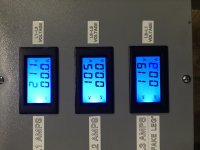I've got an old American Rotary panel. The previous owner got plenty of use out of it since he got it back in 2014. But then it blew most of the start caps and he talked to American Rotary, they talked him into a newer panel so he passed this panel to me. I made a frame around the panel and a new 40hp Baldor motor and wired it per Baldors instructions with new caps spec like the originals with same value resistors soldered on as original.
When I hit the start it just hums really loud like it's overloaded and the shaft twitches back and forth. I hit stop, spin the shaft by hand and hit start and it speeds up a little but still sounds way overloaded and doesn't speed up.
American Rotary is no help at this point. They don't have schematics on a unit this old and just want to sell me a new panel. I've torn the panel part way down and inspected and mapped everything. It seems it comes down to a bad start contactor or a bad PCB timer board.
I'm just thinking of eliminating the PCB. I can remember to not hold he start button down too long.
Power comes from L2 1ph through the NC stop switch to the white wire in one side of the three run contactors as well as the NO start button leading to the black wire to the timer board. The timer board has a white wire to trigger the start contractor and a black wire leading to the opposite side of all three run contactors from the white wires.
The remaining wires off the PCB go to L1 1ph (BK), T2 (RD), and the T3 fake leg(BL).
The rest is straight forward. Run contactors close the L1 1ph to T1 3ph and L2 1ph to T2 3ph. The Start just closes from caps energized off of T1 3ph to T3 fake leg and theres some run caps between T2 and T3.
The contactors are Schneider LC1K091OU7 start (still a good number) and LC1DT40 run (x3)(not a current number, I think it's superseded by LC1DT40U7 but need to call Schneider to know for sure.)
I'm thinking I could just add a second NO momentary sw start button from the NC stop switch to the white wire to the start contactor.
I just don't know if the PCB has step-down transformer for lower voltages/currents for controlling the contactors or latching relay-qualities to work with the momentary start button so those would be issues before i straight-up remove the timer PCB.
I'm sure someone has bypassed the timer board before.
When I hit the start it just hums really loud like it's overloaded and the shaft twitches back and forth. I hit stop, spin the shaft by hand and hit start and it speeds up a little but still sounds way overloaded and doesn't speed up.
American Rotary is no help at this point. They don't have schematics on a unit this old and just want to sell me a new panel. I've torn the panel part way down and inspected and mapped everything. It seems it comes down to a bad start contactor or a bad PCB timer board.
I'm just thinking of eliminating the PCB. I can remember to not hold he start button down too long.
Power comes from L2 1ph through the NC stop switch to the white wire in one side of the three run contactors as well as the NO start button leading to the black wire to the timer board. The timer board has a white wire to trigger the start contractor and a black wire leading to the opposite side of all three run contactors from the white wires.
The remaining wires off the PCB go to L1 1ph (BK), T2 (RD), and the T3 fake leg(BL).
The rest is straight forward. Run contactors close the L1 1ph to T1 3ph and L2 1ph to T2 3ph. The Start just closes from caps energized off of T1 3ph to T3 fake leg and theres some run caps between T2 and T3.
The contactors are Schneider LC1K091OU7 start (still a good number) and LC1DT40 run (x3)(not a current number, I think it's superseded by LC1DT40U7 but need to call Schneider to know for sure.)
I'm thinking I could just add a second NO momentary sw start button from the NC stop switch to the white wire to the start contactor.
I just don't know if the PCB has step-down transformer for lower voltages/currents for controlling the contactors or latching relay-qualities to work with the momentary start button so those would be issues before i straight-up remove the timer PCB.
I'm sure someone has bypassed the timer board before.






